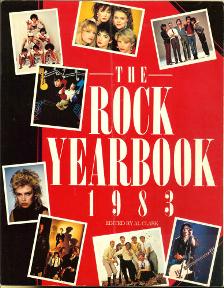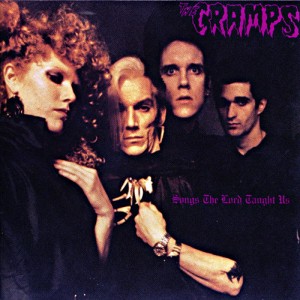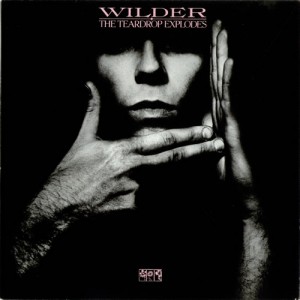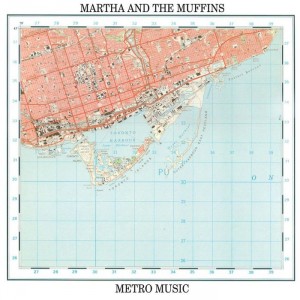In ninth grade, my musical interests shifted from hard rock heard on the radio to the new wave and punk I discovered from tape mixes and recommendations passed on by the new kids I was hanging with. I chalk this shift in listening habits up in some part to the attraction that the city held for a suburban teenager like me. I lived in McLean, Virginia, a bedroom community for politicians, civil servants and others who commuted “inside the Beltway” to Washington, DC. My father worked at the Pentagon, and my mother stayed at home with on/off spells of employment as a dental hygienist, leaving my older sister and me to preoccupy ourselves with the social life of McLean High School. While hers was quite active, mine that year was spent navigating the social tribes and discovering “who I was” — a common experience for wimpy 14-year-old middle-class boys, I’m sure.
That quest became more exciting every time my parents took us to Georgetown, the hotspot of gentrification in a city still entangled in the postwar urban crisis. Georgetown was a big deal to suburban high schoolers, for reasons both obvious (DC’s drinking age was still 18, and seniors and their friends with fake IDs could find relative anonymity in Georgetown’s loud, expansive bars) and unspoken (its racial/ethnic character was relatively white for the so-called Chocolate City). It had excellent destinations for teenage loitering like record stores and Commander Salamander, the new wave fashion and accessory store. When I could get my parents to leave me alone for a few hours, I would wander along the main roads, M Street and Wisconsin Avenue, soaking in the urban and commercial atmosphere. I wouldn’t buy much but would return home with artifacts I collected, like a flyer I held on to for a long time advertising three shows at the 9:30 Club: New Order, the Slickee Boys, and Bow Wow.
It was probably in a window of Kemp Mill Records in the spring or summer of 1983 that an oblique poster grabbed my attention. Blank white space framed a small square of what looked like an aerial image of green forest landscape. In a clinical, sans-serif font read the words MARTHA AND THE MUFFINS/DANCEPARC, a band name and album title I’d never heard of before; felt-tipped handwriting in the ample white space announced the band’s local tour date. I didn’t think anything more about the poster. I wasn’t particularly curious about this concert; while I had never attended any nightclub shows at this age, even my fantasy concert wishlist had only limited room for groups l actually listened to, like Ultravox or Simple Minds. Oh well.
That summer was an anxious one for me. My musical coming of age gained speed following my first concert, a hardcore punk show headlined by the Dead Kennedys. But my excitement about this music and the Washington, DC subculture that it came from was cut short by my father’s announcement that the Army was transferring him to a base in Belgium, and that we’d be moving overseas in July. Nothing reveals the suburban insularity and national parochialism that white, middle-class American kids are socialized into better than the outbursts, tears, and panic that follows the news they’re relocating to a small European country they’ve dimly recall from a world history class. Will I have to speak a foreign language? (French? After three years of learning Spanish??) Will I have to eat weird food? What do those people even look like??
At least I’ll be able to get deeper into new wave, I decided with a sense of acceptance, having evidently reached the final Kübler-Ross stage of grief. Anyway, it was becoming harder to buy records while maintaining the steady consumption of comic books I’d been reading since middle school. Imagining some kind of sartorial reinvention for myself along the lines of Duran Duran’s band photo on Rio, I made the mental transition: I was going to be an American teenager living in Europe. On the overnight flight into Brussels, I inaugurated my next phase as a “new European” by playing Ultravox’s Vienna on my Walkman as the plane entered over the continent.
More than three decades later, I’m still overwhelmed by the culture shock I experienced moving to Belgium at a highly impressionable age. The change in landscape immediately struck me. My father worked at Supreme Headquarters Allied Powers Europe (SHAPE), an international military base located just north of Mons, a French-speaking city with a history that predated U.S. history by the magnitude of a millenium. We lived not inside the base but “on the economy,” in a town called Soignies separated from SHAPE by 10 minutes of tidy, compact parcels of farmland. My daily busride to school drove past scores of cows grazing in flat pastures, a damp, green pastoral landscape extending behind them.
I attended SHAPE American High School, a small school (graduating class of about 60 students) that enrolled Americans alongside handfuls of Canadian students, a couple of British kids (military brats in Her Majesty’s Armed Forces generally stayed back in English boarding schools, I learned), and the few Belgian, German, Italian and Dutch kids who were game for full American English-language immersion. There were also German, Italian and French-language schools where most of SHAPE’s European military families enrolled their children. Those kids didn’t appear to experience many difficulties transitioning linguistically and culturally to Belgium. By contrast, American kids from politically conservative military families clung tenaciously to American institutions like football, permed hair, and Def Leppard.
 I made some good friends with similarly adventurous musical tastes, but few could rival my diligent research into new music. This began with a foundation of British music media: the weekly New Musical Express, the bi-weekly Smash Hits, and the monthly Face. The NME especially influenced me… what am I saying? The NME fucked me up good, and I began sneering at my classmates’ U2 records (War was on my heavy rotation just the year before) and internalizing the “1977: Year Zero” paradigm of British punk and post-punk. Also important was a random purchase: the Rock Yearbook 1983, a glossy British publication that compiled pithy album reviews ranging from the mass-market (Status Quo, Dire Straits) to the obscure (Eyeless in Gaza, Mink DeVille, Funkapolitan), as well as sections like “quotes of the year,” “best and worst album covers” and the like.
I made some good friends with similarly adventurous musical tastes, but few could rival my diligent research into new music. This began with a foundation of British music media: the weekly New Musical Express, the bi-weekly Smash Hits, and the monthly Face. The NME especially influenced me… what am I saying? The NME fucked me up good, and I began sneering at my classmates’ U2 records (War was on my heavy rotation just the year before) and internalizing the “1977: Year Zero” paradigm of British punk and post-punk. Also important was a random purchase: the Rock Yearbook 1983, a glossy British publication that compiled pithy album reviews ranging from the mass-market (Status Quo, Dire Straits) to the obscure (Eyeless in Gaza, Mink DeVille, Funkapolitan), as well as sections like “quotes of the year,” “best and worst album covers” and the like.
Then there were the many trips to record stores. If only I had back then the resources and collector’s attentiveness that I have now… Brussels had the best record-shopping destinations, my favorite being FNAC, a consumer’s paradise of books, music, videos, graphic novels, and media technologies. Mons and Soignies had one or two music stores each; from the one in Soignies, I obtained my cherished Roxy Music First Seven Albums LP box set for the 1984 price of US $35, if memory serves me correctly. On base, SHAPE’s Bon Marché superstore had a decent selection, too, with the added bonus of being across the street from school; nearby American-only bases like the one in Chièvres shipped in U.S. pressings to the PX at non-import prices. CDs were just being commercially introduced in those years and still rather pricey; thus, my collection was composed of vinyl, pre-recorded cassettes, and music I taped onto blank cassettes.
It was in this last cost-conscious pursuit of new music that I made a life-changing discovery. Between the high school and the Bon Marché was a library that extended loan privileges to members and families of the international militaries represented at SHAPE. And as I learned one day, it had a shelf of vinyl records. A few weeks ago, reminiscing about the well-worn, crackling LPs that you could check out there, a friend recalled seeing albums by King Crimson, Thomas Dolby, and the Rolling Stones, as well as a deep backlist of Bryan Adams. (Remember, Canada was well-represented at SHAPE; you should have seen the Canadians murder on the ice hockey rink.) But even that doesn’t do justice to the eclecticism of the SHAPE library vinyl collection.
Here are three albums that I checked out some time in 1984, taped to cassette, and promptly took to heart:
 1. The Cramps, Songs the Lord Taught Us (1980). I can’t overstate what a powerful effect the Cramps’ debut album had on me. Seriously, I played that tape almost everyday for a whole year between 1984-85. Typically I fast forwarded past the third track “Garbageman” for some reason — maybe because it showed the calculations behind their B-movie horror schtick too clearly, more likely because I couldn’t wait for the crazed trilogy that followed: “I Was A Teenage Werewolf,” “Sunglasses After Dark,” “Mad Daddy.” From this album I moved on to other Cramps albums (the Off the Bone compilation and the Smell of Female live album) and psychobilly compilations like Blood on the Cats, Revenge of the Killer Pussies, and Rockabilly Psychosis and the Garage Disease. The latter included a track by the Gun Club, whose discography became another obsession, one that long outlived my infatuation for the Cramps. (The beginning of the end came in the second half of the 80s, when the Cramps added a conventional bass guitar — WHY?!) Finally, from the Cramps and the Ramones, their brothers in the chord of E, I taught myself basic bar chords on guitar. This was enough for me to form my first band that year, the Wankers, whose setlist included Cramps’ covers like “Goo Goo Muck” and “New Kind of Kick.”
1. The Cramps, Songs the Lord Taught Us (1980). I can’t overstate what a powerful effect the Cramps’ debut album had on me. Seriously, I played that tape almost everyday for a whole year between 1984-85. Typically I fast forwarded past the third track “Garbageman” for some reason — maybe because it showed the calculations behind their B-movie horror schtick too clearly, more likely because I couldn’t wait for the crazed trilogy that followed: “I Was A Teenage Werewolf,” “Sunglasses After Dark,” “Mad Daddy.” From this album I moved on to other Cramps albums (the Off the Bone compilation and the Smell of Female live album) and psychobilly compilations like Blood on the Cats, Revenge of the Killer Pussies, and Rockabilly Psychosis and the Garage Disease. The latter included a track by the Gun Club, whose discography became another obsession, one that long outlived my infatuation for the Cramps. (The beginning of the end came in the second half of the 80s, when the Cramps added a conventional bass guitar — WHY?!) Finally, from the Cramps and the Ramones, their brothers in the chord of E, I taught myself basic bar chords on guitar. This was enough for me to form my first band that year, the Wankers, whose setlist included Cramps’ covers like “Goo Goo Muck” and “New Kind of Kick.”
How many other public libraries have circulated this legendary album? There’s a fascinating short story to be written about how this album was acquired. Was it a donation? Did a patron request it? Was a librarian an actual fan of the Cramps? Given the SHAPE library’s mission of international representativeness, the larger question is which national constituency it was supposed to serve. The Cramps were icons of the downtown New York scene, but they were the inspiration for British psychobilly and patron saints of London’s Batcave nightclub as well. Technically it could split the difference, but I suspect the library thought this a “British” acquisition.
 2. The Teardrop Explodes, Wilder (1981). This was surely an album acquired for British patrons; in all my new wave exchanges back in the states, I never heard mention of the Teardrop Explodes. Their debut Kilimanjaro gets the critical acclaim because it showcased the Liverpool neo-psychedelia scene so well, but I loved the bright, glossy sounds of Wilder — chiming pianos, punchy horn sections, swelling synths. Almost certainly I was reading about Julian Cope in the British music press around this time (he penned an encylopedic tribute to 1960s “flower punk” in the NME), so I was curious to understand how his acid-gobbling reputation squared with this very accessible album. I guess that was the point: his particular psychedelic lineage drew upon the daffy pop bona fides of your Syd Barretts and Arthur Lees. The somber pair of recordings that close the album, “And The Fighting Takes Over” and “The Great Dominions,” were songs to give a 14-year-old a sense of melancholy significance. Since then, I’ve been listening to Julian Cope on and off to the present.
2. The Teardrop Explodes, Wilder (1981). This was surely an album acquired for British patrons; in all my new wave exchanges back in the states, I never heard mention of the Teardrop Explodes. Their debut Kilimanjaro gets the critical acclaim because it showcased the Liverpool neo-psychedelia scene so well, but I loved the bright, glossy sounds of Wilder — chiming pianos, punchy horn sections, swelling synths. Almost certainly I was reading about Julian Cope in the British music press around this time (he penned an encylopedic tribute to 1960s “flower punk” in the NME), so I was curious to understand how his acid-gobbling reputation squared with this very accessible album. I guess that was the point: his particular psychedelic lineage drew upon the daffy pop bona fides of your Syd Barretts and Arthur Lees. The somber pair of recordings that close the album, “And The Fighting Takes Over” and “The Great Dominions,” were songs to give a 14-year-old a sense of melancholy significance. Since then, I’ve been listening to Julian Cope on and off to the present.
 3. Martha and the Muffins, Metro Music (1980). I pulled off the shelf an album with a serene blue and pink cartographic image on the cover. None of the British press mentioned Martha and the Muffins in anything I’d read so far; only my memory of the poster in the Georgetown window provided a frame of reference. I took it home and was pulled in by the first seconds of lead track “Echo Beach”: an eerie strobing keyboard tone followed by a jangling guitar riff (similar to the style of R.E.M, a new band whose debut album I had recently discovered). The album came with no musician photos to look at, but I could place the band’s sound within the classic new wave combo format (guitar, bass, drums, keyboards, optional sax) that I knew from the Attractions, Joe Jackson, B-52’s, the Cars — a style already going out of fashion by 1984.
3. Martha and the Muffins, Metro Music (1980). I pulled off the shelf an album with a serene blue and pink cartographic image on the cover. None of the British press mentioned Martha and the Muffins in anything I’d read so far; only my memory of the poster in the Georgetown window provided a frame of reference. I took it home and was pulled in by the first seconds of lead track “Echo Beach”: an eerie strobing keyboard tone followed by a jangling guitar riff (similar to the style of R.E.M, a new band whose debut album I had recently discovered). The album came with no musician photos to look at, but I could place the band’s sound within the classic new wave combo format (guitar, bass, drums, keyboards, optional sax) that I knew from the Attractions, Joe Jackson, B-52’s, the Cars — a style already going out of fashion by 1984.
Yet the band heard on the album had other features that kept me listening, starting Martha Johnson’s deep, restrained vocals — a far cry from the bouncy style of the Go-Go’s and Altered Images’ Clare Grogan or the rock belting of Pat Benatar. She was doubled by a second vocalist, Martha Ladly (two Marthas!), who sang more urgently; together, their vocals and wordplay (“Separation/Isolation/No punctuation/No fluctuation”) gave the music a fluttering of engaging repartee. I also became attuned to the reedy, plangent keyboards (Johnson’s Ace-Tone organ, I’d learn later) that evoked a feeling of strange, melancholy place on tracks like “Saigon” and “Sinking Land.” The album was energetic, even playful (on the closing “Cheesies and Gum”) but hypnotic; the band sounded intent yet unpretentious, grounded but capable of moments of enchantment. For a kid whose head was filled with dreams of making music most of his friends couldn’t bother with, this was a worthy mode of musical expression.
I asked my American friends if they had heard of Martha and the Muffins: blank stares. I asked my Canadian friends if they had heard of Martha and the Muffins: “Oh yeah… Echo Beach!” I had to find out more on my own, and, shortly after, a trip to FNAC yielded a cassette of Danceparc. With still no band photos or music reporting to consult, it took awhile for my untrained ears to figure out this was a new line-up working in a funkier, more sonically adventurous terrain. I only knew by this point that I was all in for Martha and the Muffins…
… And I still am, notwithstanding the blank stares I get when I tell my American friends and students that I’m writing a book on the band. (Increasingly, they’re joined by the blank stares of the handful of Canadian college students I’ve taught when I ask if they’ve heard Martha and the Muffins.) The routes that led me to this obscure group recapitulate theories of the urban: Washington, DC as the city of critical mass, specialized economies, and subcultural activities; the SHAPE International Library evoking Lewis Mumford’s city as the form and symbol of cosmopolitan culture.
[These 2386 words represent my attempt to write the second Musical Urbanism assignment, extended by a casual writing exercise for my Martha and the Muffins project. Here were the instructions Hua Hsu and I gave the students:
Write 800-1000 words in response to the following prompt:
For your second paper assignment, please write a brief “listening biography” detailing your relationship with a piece of music that possesses significant meaning for you. We’re interested in how this piece of music affected you at the level of imagination or self-identification. What ideas and fantasies of place or even “the urban” drew you to the work? Did it represent escape or quotidian realism? What conditions of taste or technology guided your listening habits? What role did the Internet, social circles and social networks or unlikely avenues for music discovery play? While this should be a creative, reflective endeavor, please approach this essay with some of our course discussions and themes in mind.]

